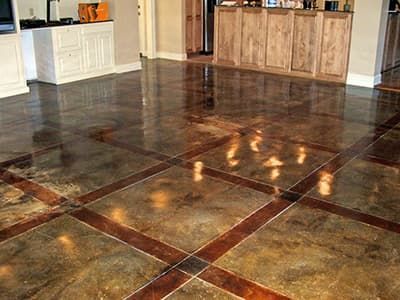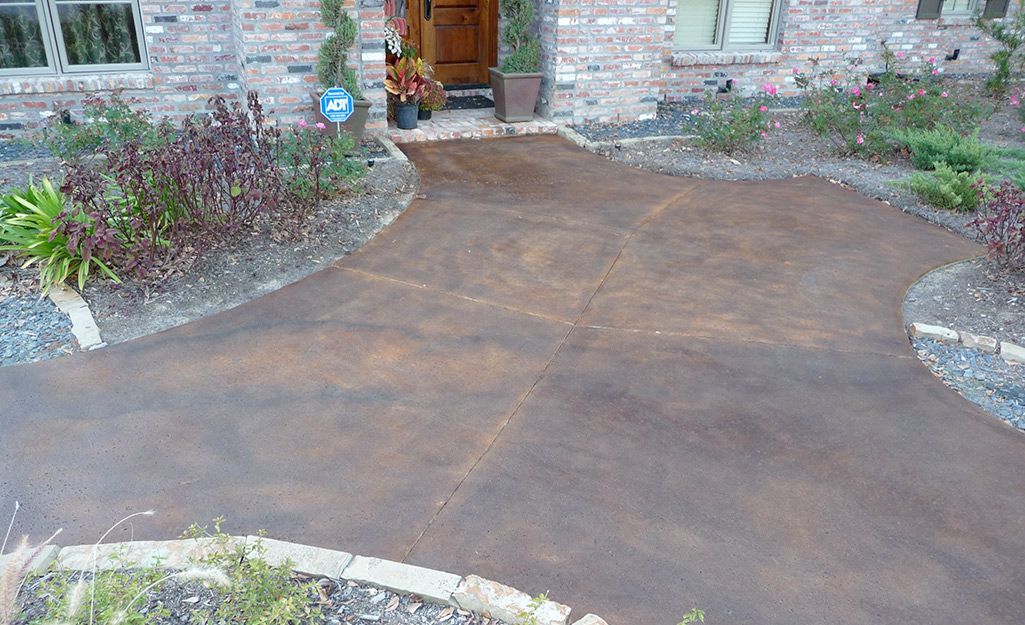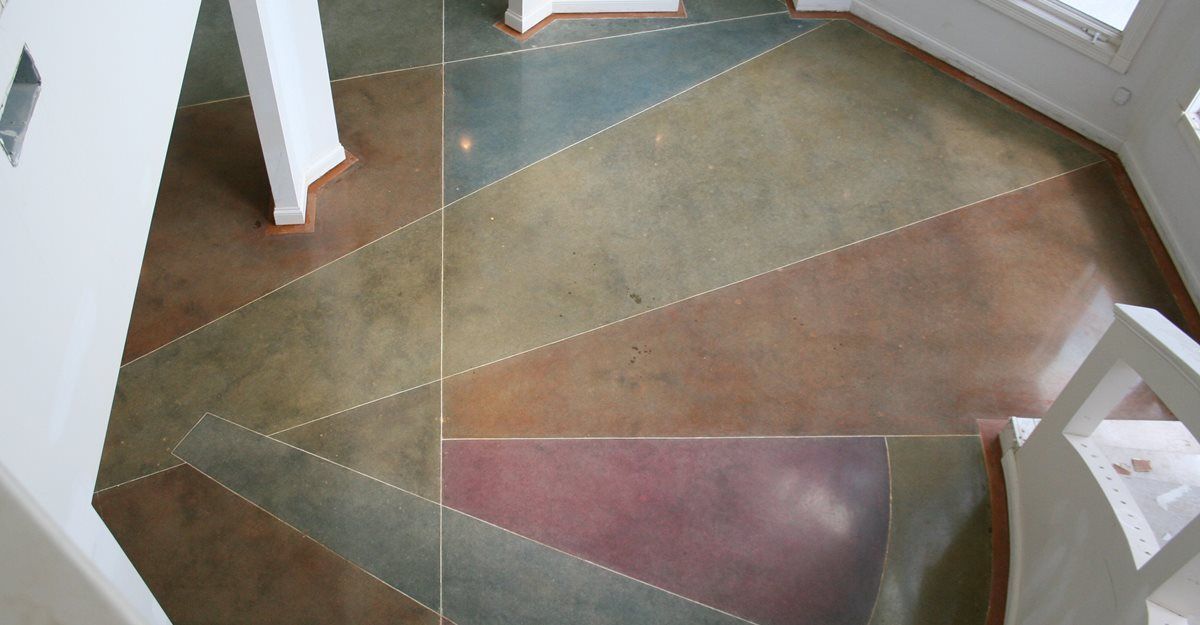Calgary Concrete Pros
Concrete Staining Calgary
Concrete staining is a process that uses various techniques and solutions to change the color of concrete. It can be used to update the look of a garage floor, walkway, or patio.
Concrete staining can make a concrete floor more durable while adding color. The stain soaks into the concrete, creating a more lasting effect than painting, which only leaves a thin layer on the surface.
There are two main types of concrete stains:
Acid-based stains
These stains are made of water, hydrochloric acid, and inorganic metallic salts. They create a permanent bond with the concrete through a chemical reaction, and are resistant to fading. Acid stains can produce deep color tones like blues, greens, tans, and browns, with marbling effects.
Water-based stains
These stains are easier to apply and come in a wider variety of colors. They dry more quickly and generally have fewer toxic chemicals than acid-based stains.
Concrete dyes
Concrete dyes are translucent, penetrating color solutions. Unlike acid-based stains, they do not react chemically with concrete. Instead, they contain very fine coloring agents that penetrate into the concrete surface. Both water- and solvent-based dyes are available, with each type having unique qualities.

Get Instant Quote

Concrete Acid Staining
Acid stains are among the oldest decorative concrete products on the market. They work by chemically reacting with the calcium compounds in the concrete. The acids and metallic salts permanently change the color in the upper portions of the concrete slab. This means two things for acid stained projects. First, the color is very durable and resistant to wear and fading. As long as the affected cement compounds are still there, the color will remain. Second, every installation is unique. Color is dependent on chemical reactions. Since no two slabs of concrete are exactly the same, every one will have unique variations in color intensity and mottling. Acid stains have several distinct advantages. From a practical standpoint, the color is very durable and long lasting. Acid stains are also very well known in the marketplace. With acid staining no two customers will every get the exact same floor.
Unfortunately, this variability can be a negative aspect for acid stains. Acid stains are more challenging to control and can be difficult to predict. The acid stain installation process leaves little room for error, too. Any finishing inconsistencies, surface contamination, surface preparation inconsistencies, or spilled stain could easily be visible in the finished product. Thankfully Calgary Concrete Pros has lots of experience staining concrete and takes great effort to make sure all of the stain residue is removed before applying a sealer.
Concrete Water-Based Stains
Water-based stained concrete pros and cons are different from other products like acid stains. This makes them a good alternative in some cases. Water-based stains are composed of inorganic pigments with polymers suspended in water. The mixture is applied to concrete. As the water absorbs, the pigments are trapped in the pores of the concrete and bonded to it with the polymer. This creates translucent color at the very surface of the concrete. Among the water-based stains pros and cons, the biggest plus sides are related to ease of use. Water-based stains are non-reactive, so they are very safe and easy to handle and apply. This also means the color development is more predictable than acid stains. Water-based stains can also be applied in a wide range of methods including sprayers, sponges, and brushes. Finally, water-based stains can be diluted and mixed to create totally unique colors and shades. Lack of innate durability is a big drawback for water-based stains. Because the color is created by pigment settled in the pores of concrete, it is subject to fading. While the pigments are UV-stable, they can wash out over time with exposure to water. That is why, when coloring concrete patio with water-based stains, for example, the stained concrete should be sealed. The sealer protection must be maintained otherwise there is a risk of degrading the color. Water-based stains also require more skill to get a properly mottled finish. Acid stains, for example, will naturally marble and mottle but water-based stains require the applicator to purposefully make every variation.
Concrete Dyes
Concrete dyes are very common. Dyes work similarly to stains and are used in some of the same situations. Dyes are made from super fine pigment particles. These come in straight powder or suspended in a small amount of liquid. The dye is then mixed with acetone or water and sprayed on the concrete surface where it rapidly absorbs. When mixed with acetone, dyes will yield stronger tinting and faster dry times. Like water-based stains, dyes are easier to use and more predictable than acid stains. Dyes absorb rapidly with minimal residue, making them great for fast turnaround construction. This rapid absorption also makes dyes a great option for touch up and stenciling work. They are less likely to migrate and bleed, making it possible to achieve crisp, dyed lines in patterns and stencils. Because dyes are often available in colors corresponding with acid stains, dyes are also a great tool for filling in and correcting areas where acid stain does not react with the concrete. The biggest limitation with dyes is a lack of UV-stability. If exposed to direct sunlight, dyes will eventually fade or turn black. This means they are not suitable for outdoor or exterior uses. Dyes are generally limited to basements, interior retail spaces, and other applications protected from UV-light. When mixed with acetone, dyes also require significant safety precautions be taken to reduce the risks associated with volatile fumes in confined spaces. This can include turning off pilot lights, using non-sparking tools, and improving ventilation. Mixing dyes with water will remove these risks at the expense of color vibrancy and rapid drying. When comparing stained concrete pros and cons, non-stain options should also be considered. Some of these products share stained concrete pros and cons, but they may bring in some other qualities that could be better or worse for an application. For example, when placing new concrete, an integral color or color hardener will produce more consistent, stronger coloration. When used in conjunction, these materials can also reproduce patterned and mottled effects to some degree. Likewise, various overlays and cementitious coatings will create more solid, durable color on existing concrete. While these are all viable coloring options for concrete, none of them will truly match what a stain or dye can do.

Should You Stain Concrete?
Staining concrete indoors such as garage floors or foundations and outdoors such as driveways, pool decks and patios is a great idea if you want to enhance property surfaces. These improvement projects are affordable and allow you to create custom colors for interior and exterior concrete. No two surfaces ever look the same due to the character of concrete, so homes and businesses have a look of their own.
Acid and water-based stains can easily get applied to old and new concrete. You have the chance to match features of a property to concrete stains varying from earth tones to a full palette spectrum.
Concrete can only be stained as long as the surface pores are reachable. We prepare concrete surfaces for staining by eliminating dirt, residues and any grime that can prevent staining contact. Sometimes by mechanical grinding or using concrete cleaning solutions and degreasers. When we are ready to apply your stain, we mask off areas you want to protected with tape. Then dilute staining coats to color preference., and apply coats via sprays or brushes, then allow the stain to dry for about 24 hours.
We can repeat the staining process until you are content with the hues. After the stain is completely dry, we rinse the surface with water until runoff turns clear, If necessary, we loosen any leftover staining with a brush, then conduct a final rinse, let the surface completely dry once more and finally apply a protective sealer of your choice.
Call Calgary Concrete Pros for all your staining or dying needs
Consider the following:
- Staining will not hide cracks or concrete damage
- Liquid solutions will change in color once you apply to concrete
- Color is long-lasting, so make sure you are happy with it by staining a small “test” section first
- Stain colors are more intense with newer concrete surfaces
- Variations in color are normal during the staining process
How much does stained concrete cost?
The cost of staining will vary considerably depending on the complexity of the stain application, surface prep requirements, and the size of the project.
Does stained concrete fade?
Because stains penetrate into the concrete surface, their colour is durable and long-lasting. When applied to properly prepared concrete, the colour will not fade, chip, or peel away
How do I maintain stained concrete?
To maintain stained concrete, you can:
Sweep away dirt and debris regularly
Pressure wash annually
Reseal the concrete every 1-2 years
Avoid parking vehicles or dragging furniture on the surface
Use furniture pads under chairs and table legs
What special effects are possible with stained concrete?
Depending on the colour and application techniques used, stained concrete can be applied to achieve almost any look you desire; it can provide a lot of colour/texture variation, have a consistent monochromatic design or anything in between.
How do I choose a stain color?
The colour you choose can be based on personal preference or to complement an existing colour scheme. Stains come in a variety of colours, including natural earth tones, blues, greens, and more. You can also blend custom colours.
Can I stain my concrete floor myself?
Yes, you can stain your interior concrete floor yourself. But it requires careful preparation, the right materials, and protective gear. We are very experienced and can take care of all your concrete staining needs
What's the difference between concrete stain and dye?
Solvent-based dyes dry quickly and can be sealed or polished almost immediately after application. This makes them a good choice for projects with a short turnaround time or stencil work.
Can concrete dye fade?
Concrete dye is usually permanent and doesn't fade, but the concrete itself can. Concrete can change over time due to weather exposure, dirt, dust, and grime
Can you die existing concrete?
Yes, we can dye existing concrete. However, the success of the dye application heavily depends on the condition of the concrete.
Old or heavily worn surfaces might need extensive preparation, such as grinding or deep cleaning. This will allow the dye to adhere properly.
